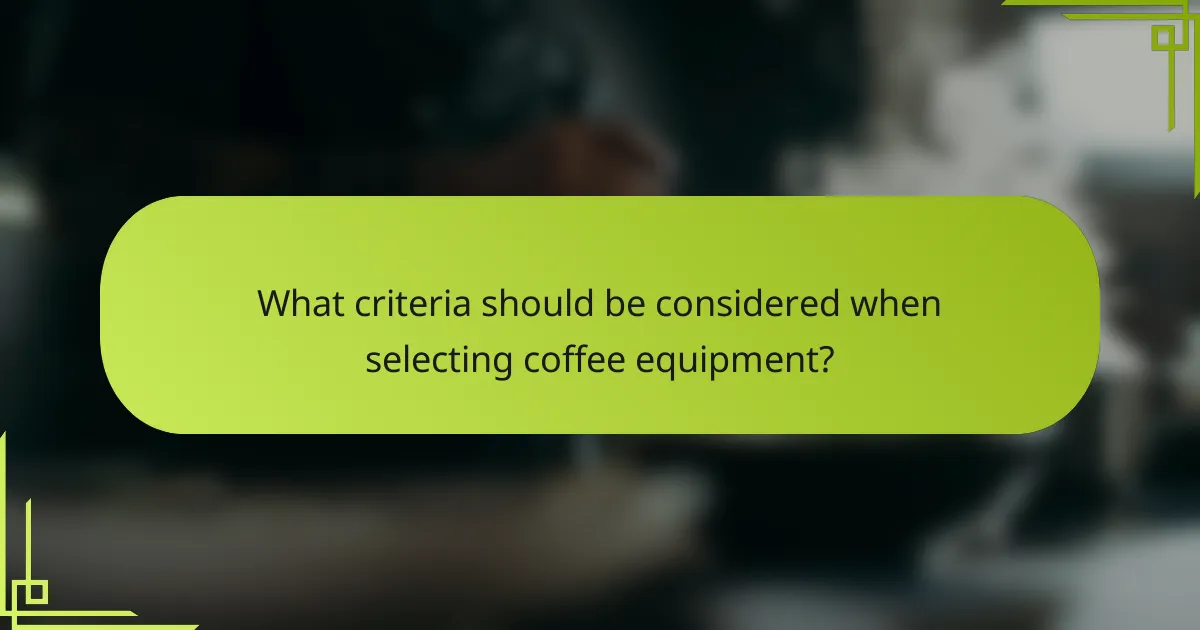Investing in coffee equipment is a crucial step for any coffee enthusiast, with initial costs ranging from a few hundred to several thousand dollars depending on quality and type. While the upfront investment may seem significant, high-quality equipment can lead to substantial long-term savings by lowering the cost per cup and enhancing the overall brewing experience. Ultimately, the right equipment not only improves flavor and aroma but also transforms home brewing into a more enjoyable ritual.

What are the initial investment costs for coffee equipment?
The initial investment costs for coffee equipment can vary significantly based on the type and quality of the equipment chosen. Generally, you can expect to spend anywhere from a few hundred to several thousand dollars to set up a home coffee station that meets your needs.
Espresso machine pricing
Espresso machines can range widely in price, typically starting around $200 for entry-level models and going up to $5,000 or more for high-end commercial machines. When selecting an espresso machine, consider factors like build quality, ease of use, and the features that suit your brewing style.
For home use, a mid-range machine priced between $500 and $1,500 often strikes a balance between quality and affordability, offering better durability and performance than budget options.
Grinder costs
A quality coffee grinder is essential for achieving the best flavor from your beans. Prices for grinders start at about $30 for basic blade models and can exceed $1,000 for high-end burr grinders. Burr grinders are recommended for their consistency in grind size, which is crucial for espresso preparation.
Investing around $100 to $300 in a good burr grinder will significantly enhance your coffee experience, as it allows for precise control over grind size and uniformity.
Brewing equipment expenses
Brewing equipment costs can vary depending on the method you choose. Basic pour-over setups can be obtained for as little as $20, while more complex systems like siphon brewers may cost upwards of $200. Consider your preferred brewing style when budgeting for this equipment.
For a versatile setup, allocate around $50 to $150 for brewing equipment, which may include a kettle, scales, and various brewing devices to suit different coffee styles.
Accessories and maintenance
Accessories such as coffee scales, milk frothers, and cleaning supplies can add an additional $50 to $200 to your initial investment. These items enhance your brewing process and ensure your equipment remains in good condition.
Regular maintenance is crucial for longevity, so factor in costs for descaling solutions and replacement parts, which can range from $20 to $100 annually, depending on usage and equipment type.

How does coffee equipment impact long-term savings?
Investing in quality coffee equipment can lead to significant long-term savings by reducing the cost per cup compared to frequent café purchases. Additionally, better equipment often enhances the overall quality of coffee, making home brewing more enjoyable and economical.
Cost per cup analysis
The cost per cup of coffee varies widely depending on the equipment used and the source of the coffee beans. For instance, brewing at home with a quality machine can bring the cost down to a few cents per cup, while purchasing from cafés can range from a couple of dollars to more than five dollars per cup.
To calculate your cost per cup, consider the total investment in equipment and the price of coffee beans over time. A simple calculation can help you see how quickly your initial investment pays off through savings.
Home brewing vs. café purchases
Home brewing typically offers substantial savings compared to buying coffee from cafés. While the upfront cost of equipment may be higher, the long-term savings can be significant, especially for daily coffee drinkers. For example, if you brew two cups daily at home, you might spend around $0.50 per cup versus $3.00 at a café, leading to savings of over $1,000 annually.
Moreover, brewing at home allows for customization, which can enhance the coffee experience. You can experiment with different beans and brewing methods without the premium café prices.
Durability and lifespan of equipment
The durability and lifespan of coffee equipment play a crucial role in long-term savings. High-quality machines often last several years with proper maintenance, while cheaper models may need frequent replacements. Investing in a reliable espresso machine or grinder can save you money over time.
When choosing equipment, consider the warranty and customer support offered by the manufacturer. A good warranty can protect your investment and ensure that you get the most out of your equipment for years to come.

What is the quality impact of different coffee equipment?
The quality of coffee is significantly influenced by the type of equipment used, affecting flavor, aroma, and overall experience. Investing in higher-quality coffee equipment can lead to better extraction and a more enjoyable cup of coffee.
Flavor differences by equipment type
Different types of coffee equipment can produce varying flavor profiles. For instance, espresso machines create a concentrated shot with rich flavors, while drip coffee makers tend to yield a milder taste. French presses often result in a fuller body due to the immersion brewing method, allowing oils and fine particles to remain in the cup.
When choosing equipment, consider how the brewing method affects acidity and bitterness. For example, pour-over methods can enhance clarity and brightness, while cold brews typically offer a smoother, less acidic flavor.
Brewing methods comparison
Brewing methods vary widely, each with unique characteristics that impact coffee quality. Common methods include espresso, drip, pour-over, French press, and AeroPress. Each method has its ideal grind size, water temperature, and brew time, which can significantly alter the final taste.
For example, espresso requires finely ground coffee and high pressure, resulting in a quick extraction that highlights intense flavors. In contrast, a French press uses coarser grounds and a longer steeping time, leading to a richer, fuller-bodied brew.
Impact of grinder quality on taste
The quality of the grinder plays a crucial role in determining the taste of coffee. A high-quality burr grinder provides a consistent grind size, which is essential for even extraction and optimal flavor. In contrast, blade grinders can produce uneven grinds, leading to over-extraction or under-extraction and a less desirable taste.
Investing in a good grinder can significantly enhance your coffee experience. Aim for a grinder that offers adjustable settings to match your brewing method, as different methods require different grind sizes for the best results.

What criteria should be considered when selecting coffee equipment?
When selecting coffee equipment, consider factors such as brand reputation, user reviews, equipment features, and specifications. These criteria can significantly influence the quality of your coffee and your overall satisfaction with the equipment.
Brand reputation and reviews
Brand reputation plays a crucial role in selecting coffee equipment. Established brands often have a history of reliability and quality, which can lead to better performance and durability. Look for brands that are well-reviewed by both consumers and industry experts.
User reviews provide insights into real-world experiences with the equipment. Pay attention to common praises and complaints, as they can highlight potential issues or advantages that may not be evident from product descriptions alone. Websites and forums dedicated to coffee enthusiasts can be valuable resources for gathering this information.
Equipment features and specifications
When evaluating coffee equipment, focus on key features such as brewing capacity, temperature control, and grind settings. For instance, machines with precise temperature control can enhance flavor extraction, while adjustable grind settings allow for customization based on the coffee type.
Specifications like build quality and ease of cleaning are also important. Stainless steel components tend to offer better longevity than plastic, and equipment that is easy to disassemble will save time during maintenance. Consider your brewing style and preferences to choose equipment that aligns with your needs.

How can coffee enthusiasts maximize their investment?
Coffee enthusiasts can maximize their investment by selecting high-quality equipment that enhances brewing consistency and flavor while considering long-term maintenance and upgrade strategies. Investing wisely in durable tools can lead to significant savings over time and a superior coffee experience.
Maintenance tips for longevity
Regular maintenance is crucial for extending the lifespan of coffee equipment. Clean your machines after each use to prevent residue buildup, which can affect flavor and performance. Use descaling solutions periodically to remove mineral deposits, especially in areas with hard water.
Additionally, replace worn parts, such as filters and gaskets, as needed. Keeping a maintenance schedule can help you avoid costly repairs and ensure that your equipment operates efficiently. Consider investing in a quality grinder, as it can significantly impact the taste of your coffee.
Upgrading equipment strategically
When upgrading coffee equipment, focus on the components that will have the most significant impact on your brewing process. Start with a high-quality grinder, as the grind size directly affects extraction and flavor. A burr grinder is often preferred over a blade grinder for its consistency.
Next, consider investing in a better brewing device, such as a pour-over setup or an espresso machine, depending on your coffee preferences. Look for equipment that offers versatility and the ability to experiment with different brewing methods. Prioritize upgrades that align with your coffee goals, and avoid unnecessary purchases that do not enhance your experience.

What emerging trends are shaping coffee equipment choices?
Emerging trends in coffee equipment are increasingly focused on sustainability and technology integration. Consumers are prioritizing eco-friendly options and smart machines that enhance brewing efficiency and quality.
Sustainable and eco-friendly options
Sustainable coffee equipment is gaining traction as consumers become more environmentally conscious. This includes products made from recyclable materials, energy-efficient machines, and those that reduce waste, such as reusable coffee filters and biodegradable pods.
When selecting eco-friendly options, consider certifications like Energy Star or Fair Trade, which indicate adherence to environmental standards. Investing in durable equipment can also lead to long-term savings by reducing the need for replacements.
Smart coffee machines and technology
Smart coffee machines are revolutionizing the brewing experience by integrating technology that allows for customization and convenience. These devices can be controlled via smartphone apps, enabling users to adjust brew strength, temperature, and timing remotely.
When choosing a smart coffee machine, look for features like programmable settings, built-in grinders, and compatibility with smart home systems. While the initial investment may be higher, the potential for improved quality and convenience can justify the cost over time.










